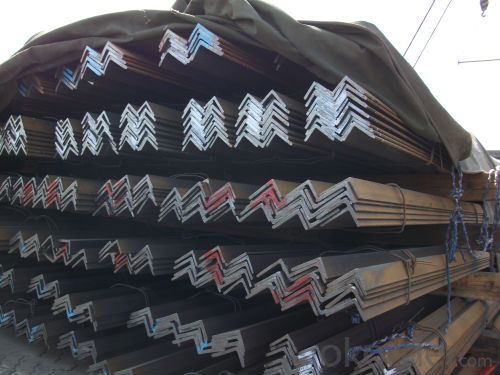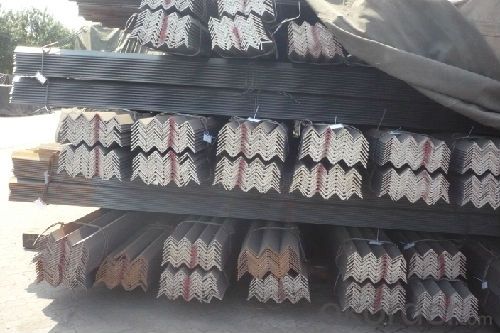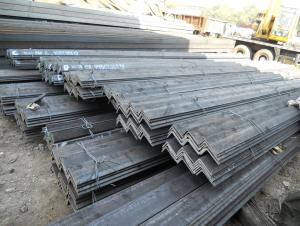Low Carbon Prime Steel Unequal Angle Bars
- Loading Port:
- Tianjin
- Payment Terms:
- TT or LC
- Min Order Qty:
- 100 m.t.
- Supply Capability:
- 20000 m.t./month
OKorder Service Pledge
OKorder Financial Service
You Might Also Like
OKorder is offering Low Carbon Prime Steel Unequal Angle Bars at great prices with worldwide shipping. Our supplier is a world-class manufacturer of steel, with our products utilized the world over. OKorder annually supplies products to African, South American and Asian markets. We provide quotations within 24 hours of receiving an inquiry and guarantee competitive prices.
Product Applications:
Low Carbon Prime Steel Unequal Angle Bars are ideal for structural applications and are widely used in the construction of buildings and bridges, and the manufacturing, petrochemical, and transportation industries
Product Advantages:
OKorder's Low Carbon Prime Steel Unequal Angle Bars are durable, strong, and wide variety of sizes.
Main Product Features:
· Premium quality
· Prompt delivery & seaworthy packing (30 days after receiving deposit)
· Can be recycled and reused
· Mill test certification
· Professional Service
· Competitive pricing
Product Specifications:
Manufacture: Hot rolled
Grade: Q195 – 235
Certificates: ISO, SGS, BV, CIQ
Length: 6m – 12m, as per customer request
Packaging: Export packing, nude packing, bundled
| UNEQUAL ANGLE STEEL | |||||
| size(mm) | a(mm) | a1(mm) | thickness(mm) | kg/m | length(m) |
| 75*50*5 | 75 | 50 | 5 | 4.808 | 6m,9m,12m |
| 75*50*6 | 75 | 50 | 6 | 5.699 | 6m,9m,12m |
| 75*50*8 | 75 | 50 | 8 | 7.431 | 6m,9m,12m |
| 100*75*7 | 100 | 75 | 7 | 9.34 | 6m,9m,12m |
| 100*75*8 | 100 | 75 | 8 | 10.6 | 6m,9m,12m |
| 100*75*9 | 100 | 75 | 9 | 11.8 | 6m,9m,12m |
| 100*75*10 | 100 | 75 | 10 | 13 | 6m,9m,12m |
| 100*75*12 | 100 | 75 | 12 | 15.4 | 6m,9m,12m |
| 125*75*7 | 125 | 75 | 7 | 10.7 | 6m,9m,12m |
| 125*75*8 | 125 | 75 | 8 | 12.2 | 6m,9m,12m |
| 125*75*9 | 125 | 75 | 9 | 13.6 | 6m,9m,12m |
| 125*75*10 | 125 | 75 | 10 | 15 | 6m,9m,12m |
| 125*75*12 | 125 | 75 | 12 | 17.8 | 6m,9m,12m |
| 150*90*8 | 150 | 90 | 8 | 14.7 | 6m,9m,12m |
| 150*90*9 | 150 | 90 | 9 | 16.4 | 6m,9m,12m |
| 150*90*10 | 150 | 90 | 10 | 18.2 | 6m,9m,12m |
| 150*90*12 | 150 | 90 | 12 | 21.6 | 6m,9m,12m |
| 200*100*10 | 200 | 100 | 10 | 23 | 6m,9m,12m |
| 200*100*12 | 200 | 100 | 12 | 27.62 | 6m,9m,12m |
| 200*100*15 | 200 | 100 | 15 | 34.04 | 6m,9m,12m |
FAQ:
Q1: Why buy Materials & Equipment from OKorder.com?
A1: All products offered byOKorder.com are carefully selected from China's most reliable manufacturing enterprises. Through its ISO certifications, OKorder.com adheres to the highest standards and a commitment to supply chain safety and customer satisfaction.
Q2: How do we guarantee the quality of our products?
A2: We have established an advanced quality management system which conducts strict quality tests at every step, from raw materials to the final product. At the same time, we provide extensive follow-up service assurances as required.
Q3: How soon can we receive the product after purchase?
A3: Within three days of placing an order, we will arrange production. The normal sizes with the normal grade can be produced within one month. The specific shipping date is dependent upon international and government factors, the delivery to international main port about 45-60days.
Images:


- Q:How do you join two steel angles together?
- To join two steel angles together, there are several methods you can use depending on the specific application and requirements. Here are a few common techniques: 1. Welding: Welding is the most common method used to join steel angles. It involves heating the joint to a high temperature and melting a filler material, usually a compatible metal, to fuse the two angles together. This creates a strong and permanent bond. Welding requires specialized equipment and expertise, so it is typically done by trained professionals. 2. Bolting: Another method is to use bolts or screws to connect the two steel angles. This involves drilling holes through both angles and then securing them with appropriate fasteners. Bolting allows for easier disassembly and modification if needed. However, it may not provide the same level of strength as welding. 3. Riveting: Riveting is a technique that uses metal pins or bolts called rivets to hold the steel angles together. It involves drilling holes through the angles and inserting the rivets, which are then hammered or pressed to form a permanent joint. Riveting is commonly used in structural applications where high strength and load-bearing capacity are required. 4. Adhesive bonding: In some cases, adhesive bonding can be used to join steel angles. Specialized adhesives are applied to the joint surfaces, and then the angles are pressed together and left to cure. This method can provide a clean and aesthetically pleasing bond, but it may not be as strong as other mechanical methods. When selecting a method to join steel angles, it is important to consider factors such as the load-bearing requirements, structural integrity, accessibility, and the specific conditions of the application. Consulting with a structural engineer or a professional in the field can help determine the most suitable technique for your specific needs.
- Q:Can steel angles be used for framing partitions and walls?
- Indeed, framing partitions and walls can be accomplished by utilizing steel angles. In construction, steel angles are extensively employed due to their robustness and longevity. A framework for partitions and walls can be established by employing steel angles, which offer structural reinforcement and stability. Steel angles possess adaptability, enabling them to be effortlessly cut and welded to fit desired dimensions and angles. Moreover, they exhibit resistance to fire, pests, and moisture, rendering them an ideal selection for framing interior walls and partitions in both commercial and residential structures.
- Q:How are steel angles protected against UV degradation?
- Steel angles are protected against UV degradation through the application of protective coatings, such as paint or galvanization. These coatings act as a barrier, preventing direct exposure to sunlight and thereby reducing the risk of UV degradation.
- Q:What are the standard dimensions for equal leg steel angles?
- The dimensions of equal leg steel angles differ based on the industry and country. Generally, these dimensions are determined by the length of each leg and the thickness of the angle. Leg lengths commonly range from 20mm to 200mm, while thicknesses range from 3mm to 20mm. These measurements are typically expressed in millimeters and can be further adjusted to suit specific project needs. To ascertain the precise dimensions for equal leg steel angles in a given situation, it is crucial to refer to industry standards and specifications.
- Q:What are the different methods of protecting steel angles against corrosion?
- Various methods are available to safeguard steel angles against corrosion, with the choice contingent upon factors such as the surrounding environment, budgetary constraints, and desired lifespan of the steel angles. Below are some commonly employed techniques: 1. Protective Coatings: The application of protective coatings stands as one of the most efficient approaches to prevent corrosion. Coatings like paint, epoxy, or polyurethane establish a barrier between the steel surface and corrosive elements. To ensure sufficient protection, multiple layers of these coatings should be applied. Regular inspections and touch-ups may be necessary to maintain the integrity of the coating. 2. Galvanization: Galvanizing steel angles involves coating them with a layer of zinc, creating a sacrificial barrier that corrodes before the steel does. This method proves highly effective in corrosion prevention, especially in harsh environments. However, it may not be suitable for aesthetic purposes as the zinc layer can alter the appearance of the steel. 3. Stainless Steel: Another means of corrosion protection is through the use of stainless steel angles. Stainless steel contains a substantial amount of chromium, which forms a passive layer on the surface, shielding it from corrosion. Stainless steel is particularly advantageous in corrosive settings like marine or chemical industries. 4. Powder Coating: The powder coating technique comprises the application of dry powder onto the steel angles, followed by heating to create a protective layer. This method offers exceptional corrosion resistance and can provide an aesthetically pleasing finish. Powder coating is commonly employed in architectural applications where aesthetics hold importance. 5. Cathodic Protection: Cathodic protection relies on an electrochemical process to thwart corrosion by designating the steel angle as the cathode in a galvanic cell. This is accomplished by connecting the steel to a sacrificial anode, often made of a more reactive metal such as zinc or magnesium. The anode corrodes in place of the steel angle, providing protection. 6. Regular Maintenance: Irrespective of the protective method employed, regular inspection and maintenance play a crucial role. This entails cleaning the steel angles, eliminating any debris or corrosive substances, and promptly rectifying any damaged or scratched coatings. Regular maintenance aids in identifying and addressing early signs of corrosion, thereby ensuring the prolonged lifespan of the steel angles. To determine the most suitable method for protecting steel angles based on specific requirements and conditions, it is imperative to consult corrosion experts or engineers.
- Q:Are steel angles suitable for earthquake-resistant structures?
- Yes, steel angles are suitable for earthquake-resistant structures. Steel is a durable and flexible material that can withstand strong seismic forces. Steel angles provide structural stability and can be used for bracing and reinforcing various components of a building, making them an effective choice for earthquake-resistant construction.
- Q:How do you connect two steel angles together?
- One common method to connect two steel angles together is through welding. Welding is the process of melting the edges of the angles and fusing them together using an electric arc or flame. This creates a strong and permanent connection between the two angles. Prior to welding, it is important to prepare the surfaces by cleaning them from any contaminants or rust. Additionally, aligning the angles properly and securing them in place with clamps or tack welds helps to ensure a precise and accurate connection. Another option to connect steel angles is through the use of bolts or screws. This method involves drilling holes through the angles and then using nuts and bolts or screws to fasten them together. It is crucial to select appropriate fasteners and ensure they are tightened securely to achieve a strong connection.
- Q:Can steel angles be used in the construction of schools?
- Yes, steel angles can be used in the construction of schools. Steel angles are versatile structural elements that can be used to create strong and durable frameworks for various construction projects, including schools. They are commonly used in the construction industry for their high strength-to-weight ratio, which makes them ideal for supporting heavy loads and providing structural stability. Steel angles can be incorporated into the design of school buildings to reinforce walls, support staircases, create open spaces, or serve as structural components for roofs and ceilings.
- Q:Can steel angles be used for temporary or removable structures?
- Steel angles, known for their versatility, find frequent use in construction for a range of purposes, including temporary or removable structures. They serve as framing components in scaffolding, support structures, and temporary partitions. Thanks to their ability to provide structural support and stability, steel angles prove ideal for temporary or removable structures that demand strength and durability. Moreover, their straightforward assembly and disassembly facilitate convenient installation and removal of such structures.
- Q:What are the alternatives to steel angles in construction?
- There are several alternatives to steel angles in construction that offer different advantages and disadvantages depending on the specific application. 1. Aluminum angles: Aluminum angles are lightweight and corrosion-resistant, making them a popular choice for outdoor construction projects. They are also easily machinable and have good electrical conductivity. However, aluminum angles may not have the same strength and load-bearing capacity as steel angles, making them less suitable for heavy-duty structural applications. 2. Fiberglass angles: Fiberglass angles are lightweight, non-conductive, and highly resistant to corrosion and chemical damage. They are commonly used in industries where exposure to harsh environments, such as water or chemicals, is a concern. However, fiberglass angles may not have the same strength as steel angles and may require additional reinforcement for heavy loads. 3. Carbon fiber angles: Carbon fiber angles are lightweight, high-strength, and have excellent resistance to corrosion. They are commonly used in applications where weight reduction is critical, such as aerospace and automotive industries. However, carbon fiber angles tend to be more expensive than steel angles and may require specialized manufacturing techniques. 4. Wood angles: Wood angles, typically made from hardwood or engineered wood products, are a traditional alternative to steel angles in construction. They are readily available, cost-effective, and easy to work with. Wood angles are often used in residential and light commercial construction projects. However, wood angles may not have the same strength and durability as steel angles and may be more prone to warping, cracking, or rotting over time. It's important to consider the specific requirements of the construction project, including the load-bearing capacity, environmental conditions, and budget, when choosing an alternative to steel angles. Consulting with a structural engineer or construction professional can help determine the most suitable option for each specific scenario.
1. Manufacturer Overview |
|
|---|---|
| Location | |
| Year Established | |
| Annual Output Value | |
| Main Markets | |
| Company Certifications | |
2. Manufacturer Certificates |
|
|---|---|
| a) Certification Name | |
| Range | |
| Reference | |
| Validity Period | |
3. Manufacturer Capability |
|
|---|---|
| a)Trade Capacity | |
| Nearest Port | |
| Export Percentage | |
| No.of Employees in Trade Department | |
| Language Spoken: | |
| b)Factory Information | |
| Factory Size: | |
| No. of Production Lines | |
| Contract Manufacturing | |
| Product Price Range | |
Send your message to us
Low Carbon Prime Steel Unequal Angle Bars
- Loading Port:
- Tianjin
- Payment Terms:
- TT or LC
- Min Order Qty:
- 100 m.t.
- Supply Capability:
- 20000 m.t./month
OKorder Service Pledge
OKorder Financial Service
Similar products
New products
Hot products
Related keywords



























